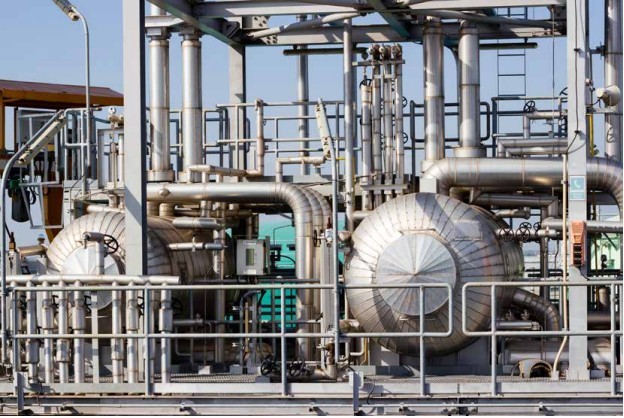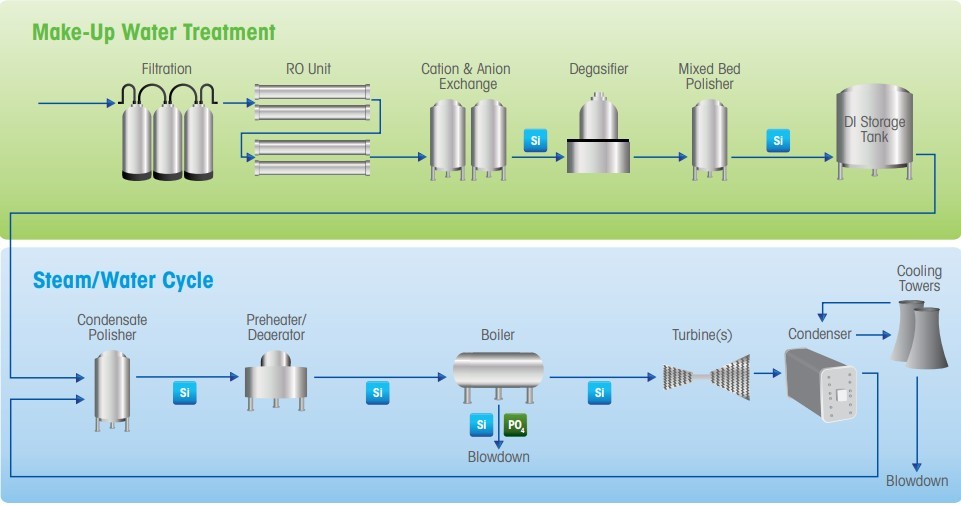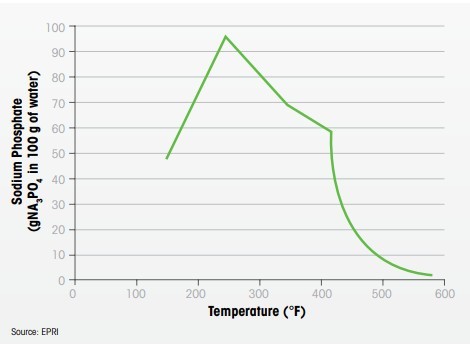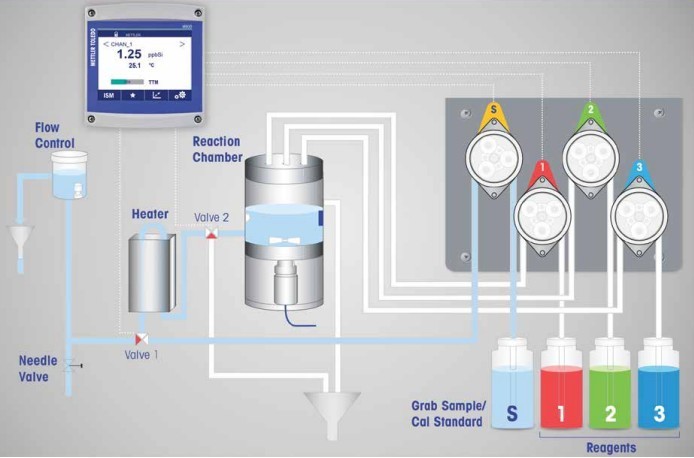On-line Silica and Phosphate Measurement to Protect Power Plant Assets
11:32 | 01/04/2022
 |
The importance of on-line analytics
With power generation companies facing a multitude of challenges ranging from tightening budgets to increasing flexible operation, simplifying the complex world of power plant chemistry is of utmost importance. Proper monitoring and control throughout the water/steam cycle enable plants to maximize reliability, safety and profitability. It begins with setting the foundation monitoring the right chemicals at the right time and under budget (see Figure 1). This has led to the importance of chemical-specific analyzers, including those for silica and phosphate, to provide dependable, automated, online measurements
Silica in the power plant water cycle
Silica, with its ability to wreak havoc on equipment efficiency and maintenance planning, is in all water supplies and requires membrane separation and/or ion exchange for its removal. With ion exchange, silica is the most loosely held anionic contaminant and therefore the first to break through an anion or mixed bed ion exchanger.
Monitoring silica in makeup water treatment immediately after anion exchange provides the key parameter for initiating regeneration. Sensing the first silica break-through and stopping the run reduces the operating cost of mixed bed ion exchangers downstream. This lowers the frequency of their more expensive and more time-consuming regenerations compared with single-bed ion exchangers.
 |
| Figure 1: Silica and phosphate measurement points throughout the power plant water system. |
Makeup water quality after mixed bed deionization can also be monitored at low ppb silica concentrations to ensure high-quality feed water is delivered to the boiler. Silica has negligible conductivity and therefore cannot be detected using conductivity measurements already present on the outlet of such mixed bed deionizers. Silica’s low conductivity combined with its constant presence in cooling water also drives ppb-level silica measurements to be the indicator of small condenser leaks and exhaustion of condensate polishers
In the water/steam cycle, silica volatilizes with steam and deposits most often in the intermediate-pressure and low-pressure sections of the turbine in a form that can only be effectively removed through mechanical means, requiring significant downtime. In the turbine, even a modest thickness of silicate reduces capacity, lowers efficiency and can cause imbalance. In the worst cases, silica build-up can cause vibration that can ultimately result in an unplanned shutdown. Silica deposits can accumulate in a very short time when steam quality is poor; therefore, continuous silica monitoring is crucial for early detection.
Phosphate boiler water treatment
Boilers and steam generators use hundreds of pipes to maximize heat-transfer surface area efficiency. This criti- cal asset comes in various types (drum, HRSGs and once-through) and runs under different pressure conditions, from low to ultra-supercritical.
Used within approximately 50% of power plant drum-type boilers, phosphate treatment plays two important roles. First, maintain proper alkalinity within the boiler water. Second, phosphate controls scale build-up for effective blowdown and protection against corrosion, for example, from a condenser leak.
Evolving over the past century with various treatment strategies (e.g., congruent or equilibrium), tri-sodium phosphate (TSP) is now recommended as the effective, safe treatment method. Target treatment levels differ based on plant design/condition and are controlled within self-imposed specification ranges, typically between 0.3 – 8 ppm, in accordance with IAPWS guidance.
Understanding phosphate levels, including hideout scenarios when solubility is low as a function of temperature (see Figure 2), enables reliable control of dosing in boilers while ensuring excessive, and often harmful, concentrations do not occur. In addition, it allows the accurate interpretation of cation conductivity relative to other contaminants.
 |
| Figure 2: Solubility of tri-sodium phosphate as a function of temperature. |
Silica and phosphate measurement: similar but different
Though serving different purposes, accurate monitoring of both silica and phosphate requires care in order to achieve consistent results, and must accommodate changes in both the sample coming in and the analyzer's optics clarity. On-line measurement methods use a molybdate reagent that produces a color change reaction with silica that is detected photometrically (see Figure 3). To achieve low-level sensitivity, the color change is enhanced using an additional reducing reagent.
Traditionally, online phosphate measurement uses the same colorimetric technique as for measuring silica, but with different reagents to produce the color change reaction. As a result, many plants use periodic grab samples for phosphate measurement in a lab, rather than managing another analyzer with a separate set of consumables and maintenance tasks. Plants accepted this more time-intensive, manual process despite sample handling risks that can result in false measurements.
Proven standards meet value-driven innovation
Optimizing established colorimetric technology, the METTLER TOLEDO Thornton 2850Si Silica Analyzer provides dependable, low ppb level silica measurements. With each measurement cycle, it re-zeroes itself on the sample to correct for any changes in sample clarity or the analyzer’s optics. In addition, configurable auto-calibration timing with standard solution level status provides increased operator confidence.
Raising the bar with unprecedented functionality, the 2850Si Silica Analyzer addresses monitoring needs of both silica and phosphate, when applicable, in boiler water. Previously requiring separate analyzers, the 2850Si provides the option to add a second measurement to determine the silica and phosphate concentrations simultaneously. With the 2850Si, plant personnel are no longer forced to choose between the high cost of managing a separate analyzer or the more time-intensive, manual grab sampling process.
 |
| Figure 3: The 2850Si uses the standard colorimetric measurement technique and common reagents for silica and phosphate monitoring. |
The 2850Si Silica Analyzer integrates Intelligent Sensor Management (ISM®) technology for continuous verification of the analyzer’s “health” through predictive monitoring. ISM is based on decades of experience with METTLER TOLEDO sensor performance in benign to extreme operating environments, and the impact of those conditions on the health and maintenance frequency of the measurement point.
A small, yet more robust enclosed or flat panel mounting design enables the 2850Si Silica Analyzer to combine reliability while meeting today's rigorous power plant operation challenges. Personnel can add flexibility with built-in, multi-stream sampling and faster measurement speeds, reduce downtime with low reagent consumption and ISM-driven predictive diagnostics. In addition, power plants can improve efficiency by saving valuable panel space with integrated phosphate measurement capability and with simple, infrequent maintenance.
Unprecedented challenges in the power industry require breakthrough technology for analytics that offer more value to users. With the METTLER TOLEDO 2850Si Silica Analyzer, power plant personnel can save space, get more measurements and lower the budget for maintenance and consumables doing more with a single analyzer than ever before.
